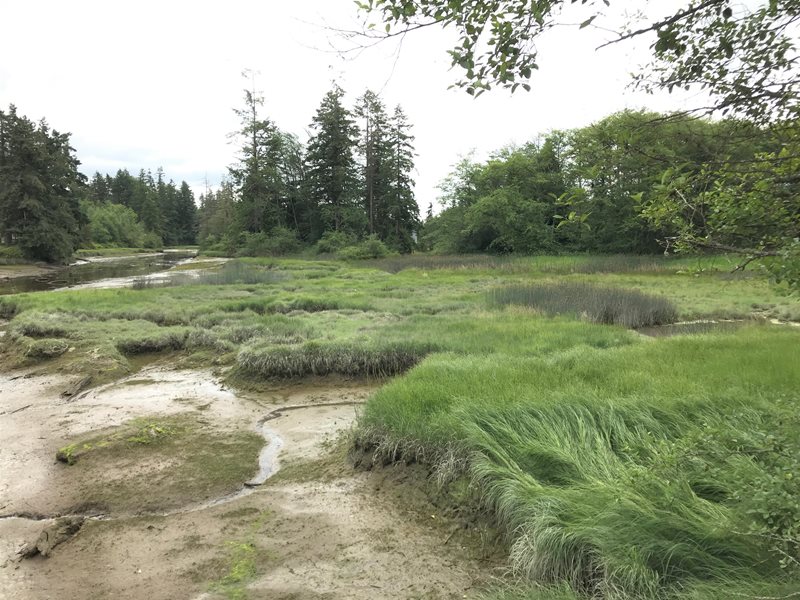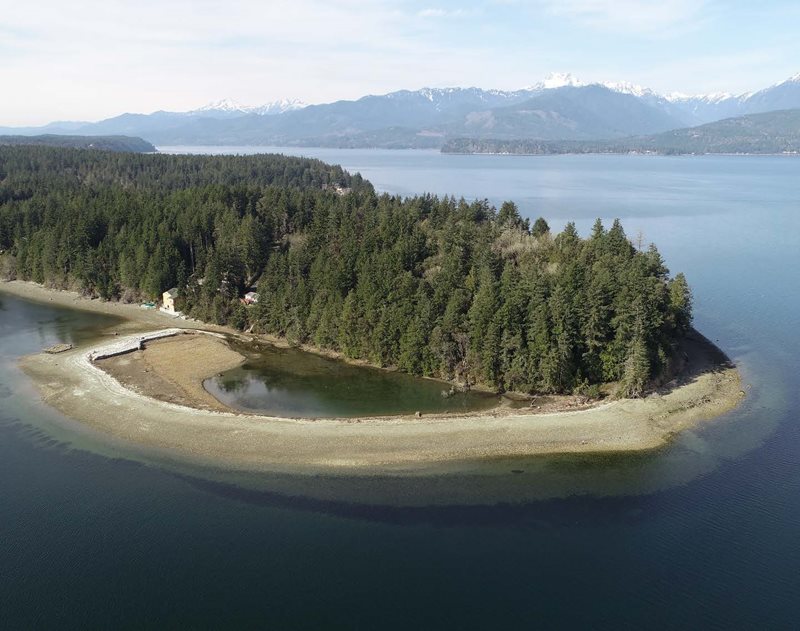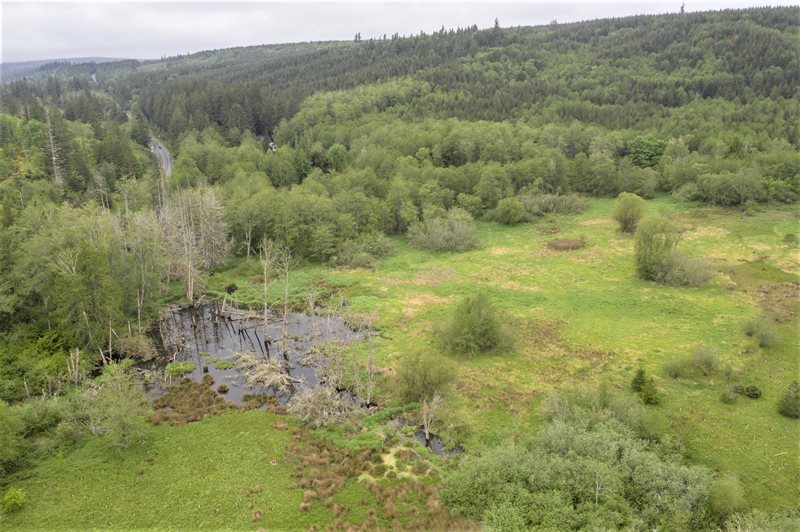In Whatcom County, mudflats and wetland marsh along California Creek draining to Drayton Harbor will be protected. Photo courtesy Solvei Metcalf.
As most Washington residents stay home and stay healthy during the coronavirus pandemic, good news can seem hard to find.
The Department of Ecology is delighted to announce we have secured seven National Coastal Wetlands Conservation grants worth more than $5 million. The 2020 federal grants will help our local partners restore and enhance nearly 500 acres of coastal wetlands and 17,500 feet of marine shoreline in Jefferson, Kitsap, Snohomish, Thurston, and Whatcom counties.
Coastal wetlands as productive as rain forests, coral reefs
Wetlands that border or are close to Puget Sound and the Pacific Ocean can be among the most complex, productive ecosystems in the world, rivaling the planet’s rain forests and coral reefs. Coastal wetlands include estuarine salt marshes as well as freshwater wetlands that extend inland within a watershed.
Washington’s coastal wetlands help support endangered Southern Resident orca whales and other marine mammals, salmon, forage fish, shellfish, waterfowl and shorebirds, and an array of other plant and animal species. They help mitigate climate change by absorbing greenhouse gases, protect water quality, reduce flooding, and recharge drinking water aquifers.
Ecology’s efforts lead the nation
While only state agencies can apply for National Coastal Wetlands Conservation grants, we work closely with our partners in local and tribal governments and conservation organizations to identify projects and develop wetland restoration and protection proposals for the federal government to consider.
Established in 1990, the conservation program is managed by the U.S. Fish and Wildlife Service and funded in part through taxes paid on fuel and equipment purchases by recreational anglers and boaters. The federal program provides up to $1 million for individual wetland projects in coastal and Great Lake states as well as U.S. territories.
Over the last 30 years, we’ve been successful in helping projects totaling about $122 million conserve more than 13,000 acres of coastal wetlands and shorelines in Washington.
By securing $5 million for seven coastal wetland restoration projects for 2020, Washington received more grant funding for more projects this year than any other state in the nation. We have posted more details about each particular 2020 project.
Washington’s 2020 coastal wetland conservation projects
The 2020 federal grants will help fund the following coastal wetland acquisition and restoration projects. We've posted more details about the each grant project:
Discovery Bay.
Discovery Bay Acquisitions ($713,268) —working in partnership with Jefferson Land Trust to acquire and conserve 9 acres of critical wetlands and nearshore habitat in Discovery Bay in Jefferson County, including nearly 2,173 feet of Puget Sound shoreline. The project will conserve degraded and filled estuary and nearshore habitat and preserve a rare intact pocket estuary that provides high-functioning salt marsh habitat in the Discovery Bay area.
Drayton Harbor and California Creek Estuary ($915,000) — this project, in collaboration with the Whatcom Land Trust will acquire and restore four parcels totaling 54.66 acres of coastal wetland habitat and 6,500 feet of shoreline. All four parcels are situated along California Creek, a tributary stream to Drayton Harbor in Whatcom County.
Photo courtesy Matt Balder.
Lower Eld Inlet Acquisition Phase 3 ($355,000) — in partnership with the Capitol Land Trust, this project will acquire and permanently protect 55 acres, including 3,250 feet of shoreline on Lower Eld Inlet and the McLane Creek estuary in Thurston County. The project will acquire and permanently protect one 15-acre parcel and eight contiguous 5-acre parcels that are already adjacent to nearly 600 acres of habitat and 6 miles of shoreline protected by previous grants.
Photo courtesy Russ McMillan.
Lower Henderson Inlet Habitat Acquisition Phase 2 ($574,000) — we’re working with the Capitol Land Trust to permanently protect 94.18 acres and 2,100 feet of Puget Sound shoreline in Thurston County through a conservation easement. The project supports Chinook and Coho salmon and steelhead trout by building on the recent successful acquisition and restoration project of more than 150 acres on the opposite shore of Henderson Inlet, funded through a 2017 grant.
Photo courtesy Anthony Gibbons.
Misery Point Habitat Acquisition ($1 million) — this collaborative project with the Great Peninsula Conservancy will preserve 20.7 acres and approximately 3,500 feet of Hood Canal and barrier lagoon shoreline in Kitsap County. The property contains a 1,600-foot sand spit that shelters a 3-acre tidal lagoon, important refuge habitat for juvenile salmon and waterfowl.
Photo courtesy Jason Griffith.
Stillaguamish Tidal Wetland Acquisition ($1 million) — in partnership with the Stillaguamish Tribe of Indians, we will help acquire 248 acres of former estuarine and marine wetlands in Snohomish County. The goal is to return coastal wetland acres back to tidal and riverine influence to benefit a wide range of fish and wildlife species in the Stillaguamish and Skagit rivers.
Photo courtesy John Gussman.
Tarboo Creek Wetlands Acquisition and Restoration ($508,000) — in close coordination with the Northwest Watershed Institute we will help permanently protect and restore 14.5 acres of wetlands on three adjoining parcels along Tarboo Creek in Jefferson County that drain directly to Tarboo-Dabob Bay and Puget Sound.
Wetland tools and resources
Want to know more? We provide technical assistance and develop tools for local governments, consultants, and developers regarding the responsible management, regulation, and stewardship of our wetlands.








